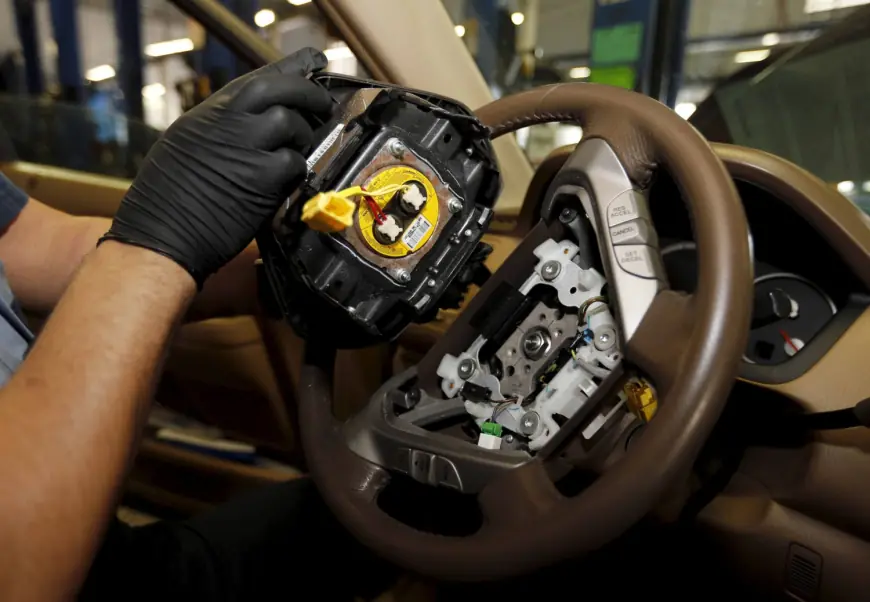Automotive Airbag Inflator Market 2030 Competitive Edge
A primary driver of the Global Automotive Airbag Inflator Market is the stringent regulatory landscape and the overarching emphasis on vehicle safety.

Introduction
The Global Automotive Airbag Inflator Market has established itself as a vital segment of the automotive industry, playing an indispensable role in passenger protection and safety innovation. Valued at USD 15.30 billion in 2023, the market is projected to expand at a CAGR of 3.82% through 2029, underscoring the rising importance of advanced safety technologies in vehicles across the globe.
Airbag inflators, the core components responsible for rapidly deploying airbags during collisions, have transitioned from basic mechanical devices to technologically sophisticated systems. These advancements are driven by stricter government safety regulations, increasing consumer awareness, and the global rise in road traffic accidents. Today’s automotive industry is not only prioritizing efficient crash protection but also exploring intelligent, adaptive, and eco-friendly inflator systems that align with the next era of mobility, including electric and autonomous vehicles.
This article provides an in-depth exploration of the market, highlighting emerging trends, key drivers, industry insights, future prospects, competitive analysis, and the benefits of comprehensive research reports for industry stakeholders.
Market Overview
Airbag inflators are highly engineered devices designed to release gas within milliseconds of detecting a collision, inflating the airbags to protect passengers from severe injury. The market’s expansion has been shaped by a confluence of technological innovation, regulatory mandates, and heightened consumer expectations for advanced safety features.
Global demand is being fueled by:
- Stringent regulations that require airbags in all passenger and commercial vehicles.
- Urbanization and increasing road traffic, leading to greater emphasis on safety systems.
- Automakers’ competitive strategies to achieve higher safety ratings, influencing consumer purchase decisions.
With more side airbags, curtain airbags, and knee airbags being installed, the airbag inflator industry is expanding beyond traditional driver and passenger airbags. The integration of sensors, AI, and connected systems is further transforming the design and functionality of inflators.
Download Free Sample Report: https://www.techsciresearch.com/sample-report.aspx?cid=22005
Emerging Trends in the Automotive Airbag Inflator Market
1. Smart Airbag Systems
Traditional airbags are being replaced by intelligent airbag systems that deploy based on collision severity, occupant size, seating position, and seatbelt usage. Inflators in these systems must respond with extreme precision, leading to higher demand for multi-stage and adaptive inflators.
2. Eco-Friendly Propellant Technologies
Sodium azide, once the dominant propellant, is being phased out due to safety and environmental concerns. Manufacturers are moving toward nitrogen-based propellants and hybrid inflators that ensure cleaner, safer deployments while meeting sustainability goals.
3. Integration with Electric and Autonomous Vehicles
As EVs and autonomous vehicles grow in popularity, inflators are being redesigned to accommodate unique crash profiles and passenger positions. For instance, autonomous shuttles may require inflators to deploy airbags from unconventional angles, creating new opportunities for innovation.
4. Rise in Side and Curtain Airbags
The side airbag segment is experiencing the fastest growth. With the rising frequency of side-impact collisions, inflators for side airbags are in high demand. These airbags deploy from the seat or door panels, requiring specialized inflators that can operate in confined spaces.
5. Digital Simulation and Testing Technologies
Virtual crash simulations and AI-driven predictive testing are reducing the need for physical prototypes, lowering costs, and accelerating the development of next-gen inflators.
6. Modular Inflator Designs
Automakers and suppliers are investing in standardized and modular inflators that can be adapted across multiple vehicle platforms, cutting costs while maintaining performance.
Key Market Drivers
1. Increasing Road Traffic Accidents
Rising global vehicle usage and road density have heightened the incidence of traffic accidents. Governments and consumers are demanding enhanced protective measures, driving demand for airbag inflators.
2. Regulatory Mandates and Safety Standards
Countries across North America, Europe, and Asia-Pacific have enacted strict safety regulations that require airbags in vehicles. Compliance with NCAP (New Car Assessment Program) safety ratings is a strong driver of inflator adoption.
3. Consumer Awareness and Demand for Safety
Modern buyers prioritize safety as a key purchase criterion. Vehicles with higher safety ratings are often perceived as premium products, incentivizing manufacturers to integrate advanced inflator systems.
4. Technological Innovations
Smart inflators, multi-stage deployments, and eco-friendly propellant systems are creating new business opportunities while improving overall passenger protection.
5. Expansion of Electric and Autonomous Vehicles
The structural differences and driving dynamics of EVs and self-driving vehicles necessitate specialized safety solutions, prompting innovation in inflator design.
6. Growth in Emerging Economies
Rapid vehicle sales growth in Asia-Pacific, Latin America, and the Middle East is opening new markets for inflator manufacturers, particularly as governments in these regions update vehicle safety standards.
Industry Key Highlights
- Market Size: USD 15.30 billion in 2023, expected to grow steadily through 2029.
- Growth Rate: CAGR of 3.82% forecasted for 2024–2029.
- Segment Growth: Side airbags are the fastest-growing type.
- Regional Growth: Asia-Pacific leads in production, while North America and Europe dominate in regulatory-driven adoption.
- Technological Shift: Transition toward hybrid inflators and nitrogen-based propellants.
- Competitive Edge: Companies are investing in modular and adaptive inflator systems to maintain leadership.
Competitive Analysis
The Global Automotive Airbag Inflator Market is highly competitive, characterized by innovation, compliance challenges, and strategic partnerships.
Key Players Include:
- Autoliv Inc. – A leader in advanced safety solutions, investing in smart inflators.
- ZF Friedrichshafen AG – Focused on modular inflator designs adaptable across platforms.
- Joyson Safety Systems – Strong in integrating inflators with full airbag systems.
- Toyoda Gosei Co., Ltd. – Innovating sustainable inflator propellant technologies.
- Daicel Corporation – Specialized in hybrid inflators with advanced materials.
- Nippon Kayaku Co., Ltd. – Key player in propellant chemistry.
- Robert Bosch GmbH – Leveraging electronics expertise to advance inflator systems.
- ARC Automotive, Inc. – Known for stored gas inflator technology.
- Hyundai Motor Company – Integrating inflator technologies into in-house vehicle production.
Competitive Landscape Strategies:
- R&D Investments: Focused on safer, eco-friendly inflator materials.
- Partnerships & Acquisitions: Collaborations between automakers and safety suppliers.
- Regional Expansion: Targeting growth in emerging economies.
- Regulatory Alignment: Companies ensuring compliance with evolving global safety mandates.
Future Outlook
The future of the automotive airbag inflator market is deeply tied to technological innovation, regulatory pressure, and the transformation of mobility. By 2029, the market is expected to become more diverse, intelligent, and sustainable, with inflators designed not only for crash protection but also tailored to evolving passenger needs in autonomous driving environments.
Key trends expected in the future include:
- Integration of AI and predictive maintenance in airbag systems.
- Customizable safety solutions for shared mobility and ride-hailing services.
- Growth of eco-friendly inflators supporting global sustainability initiatives.
- Advanced inflators optimized for next-generation electric and autonomous vehicles.
10 Benefits of the Research Report
- Provides accurate market size and forecast data for strategic planning.
- Identifies emerging trends shaping the future of the industry.
- Highlights regional insights for targeted market expansion.
- Delivers in-depth competitive analysis of leading players.
- Offers clarity on regulatory landscapes influencing inflator adoption.
- Examines technological advancements and their implications.
- Assists stakeholders in investment decision-making with reliable insights.
- Highlights growth drivers and restraints impacting demand.
- Explores opportunities in EVs and autonomous vehicle safety systems.
- Provides customizable intelligence tailored to business objectives.
Conclusion
The Global Automotive Airbag Inflator Market is undergoing a transformative phase, evolving from basic safety components to highly advanced, adaptive systems tailored for the next generation of vehicles. Driven by regulatory mandates, technological innovations, and consumer demand for safety, the industry is poised for steady growth through 2029.
While challenges such as recalls and material safety remain, the collective commitment of manufacturers, regulators, and automakers to advancing passenger safety ensures continued innovation and resilience in the market.
Contact Us-
Mr. Ken Mathews
708 Third Avenue,
Manhattan, NY,
New York – 10017
Tel: +1-646-360-1656
Email: [email protected]
Website: www.techsciresearch.com
What's Your Reaction?
 Like
0
Like
0
 Dislike
0
Dislike
0
 Love
0
Love
0
 Funny
0
Funny
0
 Angry
0
Angry
0
 Sad
0
Sad
0
 Wow
0
Wow
0




















































